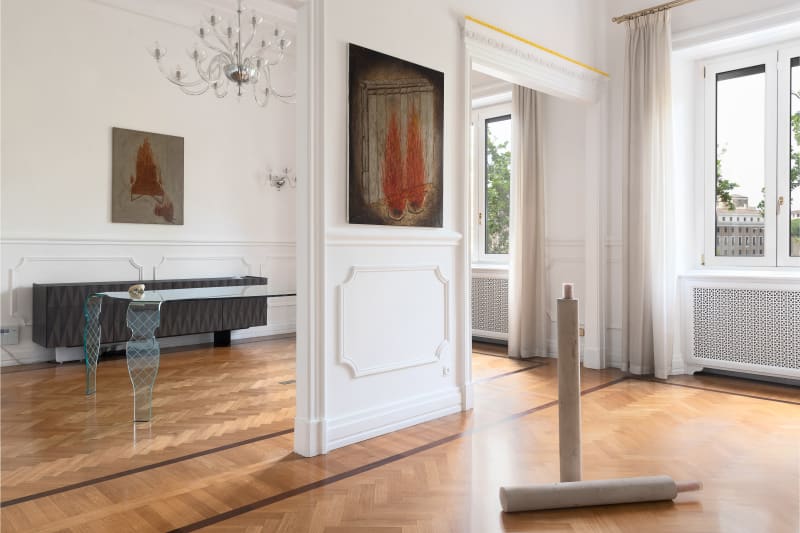Andrea Festa Fine Art presents a solo exhibition by Andreas Zampella "Piano d’ascolto" curated by Nicolas Martino. The exibition runs from 27th of May untill 22nd of July 2022.
This exhibition is not what it seems. You are not looking at the works, instead, they are being framed while listening to you. The title itself says it all, this is a listening place. But are you inside or outside the performance space? Who is the actor and who is the spectator?
Try looking at the “Sipario verde” (2016-2022) that Andreas painted by piling up the rags used to clean his brushes: where are we? If to orientate means to be facing East, where the sun rises and therefore where the light comes from, to disorientate evidently means to lose a point of reference that we thought to be certain. To be disoriented then means to realize that home, the one in which we were born and lived feeling safe, is on fire, and can only be abandoned. But so is our presumed identity, eroded by a game of masks in which, as Erving Goffman taught us, we are all always playing roles within a frame from which we are constantly entering and leaving.
It is no coincidence that theatre is a fundamental reference in the Zampella’s work, presenting here above all a series of recent works (realised between 2020 and 2022) resolved in painting - and perhaps in contemporary art there is no more difficult and ambitious challenge than that of trying to re-invent painting -, even though he is an artist profoundly linked to performative action. If in fact Andreas' reference is the painting of Enzo Cucchi, a certain violence characteristic of Viennese Actionism, and of Hermann Nitsch in particular, resonates in this mise-en-scene in which the remains of a world that never stops observing us as they sink. Remains of arms and hands, remains of legs and feet, limbs that no longer articulate and become something else.
Try looking at the “Sipario verde” (2016-2022) that Andreas painted by piling up the rags used to clean his brushes: where are we? If to orientate means to be facing East, where the sun rises and therefore where the light comes from, to disorientate evidently means to lose a point of reference that we thought to be certain. To be disoriented then means to realize that home, the one in which we were born and lived feeling safe, is on fire, and can only be abandoned. But so is our presumed identity, eroded by a game of masks in which, as Erving Goffman taught us, we are all always playing roles within a frame from which we are constantly entering and leaving.
It is no coincidence that theatre is a fundamental reference in the Zampella’s work, presenting here above all a series of recent works (realised between 2020 and 2022) resolved in painting - and perhaps in contemporary art there is no more difficult and ambitious challenge than that of trying to re-invent painting -, even though he is an artist profoundly linked to performative action. If in fact Andreas' reference is the painting of Enzo Cucchi, a certain violence characteristic of Viennese Actionism, and of Hermann Nitsch in particular, resonates in this mise-en-scene in which the remains of a world that never stops observing us as they sink. Remains of arms and hands, remains of legs and feet, limbs that no longer articulate and become something else.
The chairs and beds we inhabited are shadows of our memories. Isn't it true that disorientation, end and metamorphosis are key words of our age? As Ernesto De Martino taught us, we inhabit a world that ends and where everything becomes something else, overcoming the boundaries of identification. But is it possible to leave the theatre? According to Arthur Schopenhauer, it would be possible by escaping from the trap of our will, a thought that probably also fascinates Andreas, who, however, replaces the North European consolation that smells of incense with the Mediterranean lucidity of irony. The same irony typical of picarians who has never needed any philosophy, preferring a materialist ethic devoid of illusions.
The ethics of our bodies, and flesh, rebelling against the constraints of clothes and incessantly forcing the limits within which they cannot stay. Here is Zampella's interlocked flesh, "Incastro" (2022), pressing the boundaries of stones and resins, the straitjackets we too often wear, because it is in resisting that the solution to the puzzle lies. There is no elsewhere, there is no salvific exit from the staging, there is rather the resistance that, alone, makes us aware. But of what? Of the illusion of passing days, "Calendario" (2021), of the domestic spectacle of our everyday life, even in its smallest details, and of the impossibility of escape. The only human figure in the exhibition observes you.
Do you recognise yourself riding a bicycle in an attempt to escape? In “Passaggio tra le sfingi” (2022), guard dogs bar the way, sentinels of the poetic word that has value in itself, not as utopia. Poetry is a device that fights the wear and tear of the word, but if, as Giorgio Manganelli used to say, 'the world is papery and a great fire touches it', from this game, or rather from this plane of listening, one does not get out. Or does one? Exiting, after all, also means entering. And have you entered or exited the space of this play? "Arrendersi per sempre" (2022), then? No, we can only bite into this world we lose, our “orso” (2022) keeps us irrevocably anchored to a representation that listens to us.


